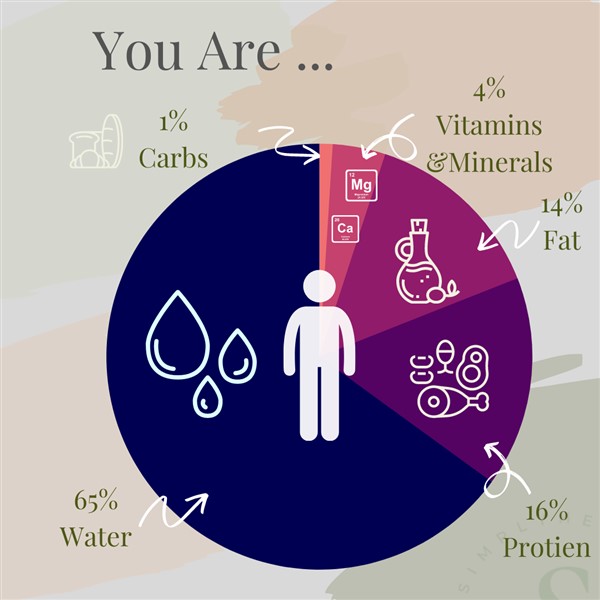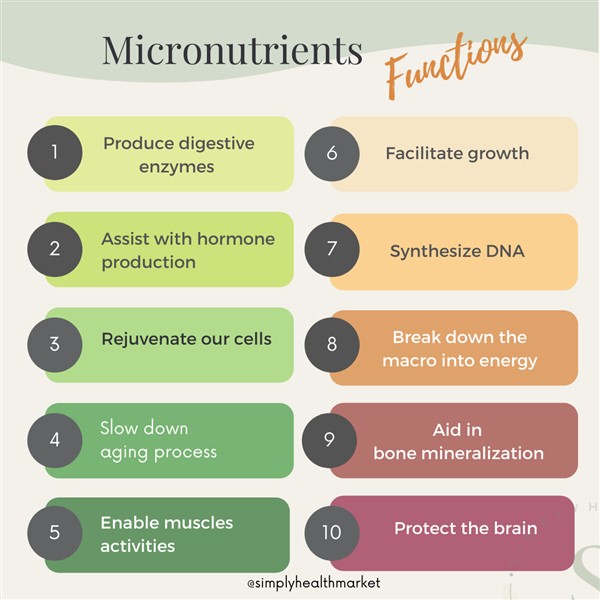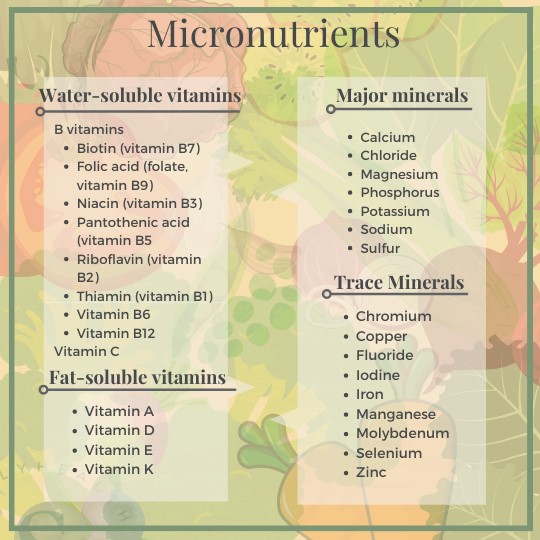We all know that we drink water, and we eat specific quantities of carbs, protein, and fats. We call these the macronutrients of our diets. The minerals and vitamins come along with the carbs, proteins, and fats we eat and are known as the micronutrients.
And it just so happens the human body is approximately 65% water, 16% protein, 14% fat, 1% carbs, and 4% minerals and vitamins.
- Macronutrients
- Micronutrients
- Water
- Carbs, Proteins, and Fats.
- Vitamins and Minerals.
- Water
- 31% of our total body
- 4% of our total body
- 65% of our total body

Macronutrients & Micronutrients Purpose
Macronutrients, carbs, protein, and fats are those nutrients that our bodies need in large amounts. They supply our bodies with the energy (calories) we need and serve as the building blocks for our bones, muscles, tissue, and organs.
On the other hand, we need very little micronutrients, but this is where the magic happens. The micronutrients enable the body’s metabolism to function correctly, assisting in producing enzymes, formulating our chemical messengers, the hormones, and essential compounds necessary for life.
They facilitate or enable the production and storage of our energy needs. They are the supporting cast for the immune system, and they maintain and regulate the nervous system. They revitalize our muscles, our organs, and our bone structure. They assist in digestion, fluid balance, and blood flow. They rejuvenate the cells, heal the wounds, and protect the brain.

The 2 Classes of Vitamins.
Water-soluble. These vitamins dissolve in water, are used up quite quickly by the body, and must be replenished regularly.
FOR EXAMPLE, the B vitamins are water-soluble and essential for our metabolism to function, our energy production, and our blood health.
While vitamin C, also water-soluble, is necessary for tissue growth, boosting the immune system, and keeping common infections and viruses at bay.
Fat-soluble: These vitamins can be dissolved in fat and stored in your liver and your fat cells. These are used up at a much slower pace by the body.
The vitamins A, D, K, and E are fat-soluble and crucial for healthy eyesight, strengthening the immune system, developing our bones, healing injuries, and nourishing the heart.
The 2 Classes of Minerals.
Microminerals. These are essential nutrients. Calcium, magnesium, sodium, and potassium are among them. They’re necessary for maintaining muscle and bone health. They also help to keep your blood pressure in check.
Trace minerals. Iron, manganese, copper, zinc, and selenium are some of the other minerals you’ll need. Trace minerals are essential for your muscle health, central nervous system function, and cell repair.

How Do We Get Our Micronutrients.
Naturally, the most effective way to ensure the adequate intake of minerals and vitamins is by eating a wide variety of whole-natural foods.
No single food contains all of the micronutrients we require, so variety in the foods we eat is essential. Eating a diverse range of whole foods. Eat the Rainbow, as they say. Fresh vegetables, fruits, beans, nuts, whole grains, lean meats, seafood, and eggs.
Needless to say, we need to eat as close to whole foods as we can. The more nutritious the macros we consume, the more potent the magic of the micros.

